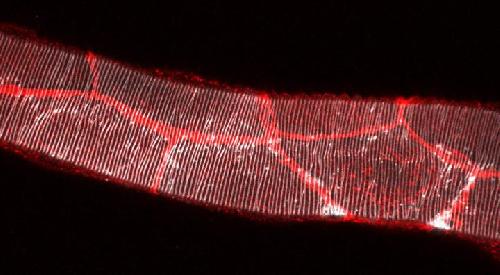The cells of an organism interact not only with each other but with the extracellular matrix that surrounds them. Increasing evidence is unveiling the relevance of this structure--which is secreted by the cells themselves-- for the correct function of the organism and also for the development of various diseases.
A new study published in eLife and headed by Jordi Casanova and Sofía J. Araújo, both scientists at the Institute for Research in Biomedicine (IRB Barcelona) and the Instituto de Biología Molecular de Barcelona (IBMB-CSIC), describes a cell communication mechanism that allows the organisation of the extracellular matrix and how this structure affects cells through a feedback system.
For this study, the team of researchers used the fruit fly Drosophila melanogaster--a particular useful model for biomedical research. The study focused on the tracheal system, tubes that are analogous to the function of the human respiratory apparatus. This system has an extracellular matrix that covers the inside of the trachea, forming a structure that is comparable to the hose of a vacuum cleaner. Until now, it was believed that this matrix served only a structural purpose, preventing the tube from collapsing, but the team of scientists has demonstrated that it also regulates the cells that form it.
 Image of the larval tracheal main tube, stained in white to mark the chitinous extracellular matrix and in red to mark the cell-cell junctions. Credit: IRB Barcelona
Image of the larval tracheal main tube, stained in white to mark the chitinous extracellular matrix and in red to mark the cell-cell junctions. Credit: IRB Barcelona
In 1929, the Canadian biologist W. R. Thompson published a study describing the tracheal system and its structure. Although he was able to describe it, he was unable to explain how it formed. This new study now provides an explanation of this 80-year enigma.
"The biological context of these cells modifies not only their behaviour but also their internal structure," comments Casanova. "When we modify only the extracellular matrix, the cytoskeleton is also altered."
"It is a two-fold mechanism," says Sofía Araújo. "First actin filaments, a very important component of the cytoskeleton, serve as a mould for the deposition of the chitin of the matrix. Next, the matrix itself stabilises the cytoskeleton, anchoring actin in place." The scientists propose that Src42A--a protein that belongs to the family of kinases that regulates the structure of the actin filament--is one of the main contributors to this system.
Casanova considers that the study explains one of the many mechanisms that allow communication between the extracellular matrix and cells. "The way in which cells communicate has been conserved over evolution: we are sure that this process will be discovered in other organisms. In our lab, we address how such communication allows cells to arrange themselves in such a way as to form tissues."
The interaction between the cell and its extracellular matrix is also very important in inflammatory and cancer processes. "Tumour cells often take advantage of existing mechanisms, such as the one we have described, to cause havoc. The unravelling of these mechanisms may provide us with new tools to study diseases," concludes Casanova.
source: Institute for Research in Biomedicine (IRB Barcelona)